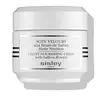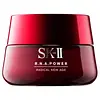What's inside
What's inside
 Key Ingredients
Key Ingredients

 Benefits
Benefits

 Concerns
Concerns

 Ingredients Side-by-side
Ingredients Side-by-side

Water
Skin ConditioningPropylheptyl Caprylate
EmollientGlycerin
HumectantMacadamia Integrifolia Seed Oil
Skin ConditioningCetearyl Alcohol
EmollientButylene Glycol
HumectantButyrospermum Parkii Butter
Skin ConditioningSqualane
EmollientGossypium Herbaceum Seed Oil
Skin ConditioningHelianthus Annuus Seed Oil
EmollientGlyceryl Stearate Citrate
EmollientCetearyl Glucoside
EmulsifyingSaccharide Isomerate
HumectantPanthenol
Skin ConditioningTocopheryl Acetate
AntioxidantOphiopogon Japonicus Root Extract
Skin ConditioningCrocus Sativus Flower Extract
MaskingPolygonum Fagopyrum Seed Extract
Skin ConditioningTocopherol
AntioxidantPadina Pavonica Thallus Extract
Skin ConditioningSimmondsia Chinensis Seed Oil
EmollientCetyl Alcohol
EmollientPropanediol
SolventEthylhexylglycerin
Skin ConditioningHydroxypropyl Starch Phosphate
Hydroxyethyl Acrylate/Sodium Acryloyldimethyl Taurate Copolymer
Emulsion StabilisingGlycine Soja Oil
EmollientCitric Acid
BufferingPolysorbate 60
EmulsifyingSorbitan Isostearate
EmulsifyingSodium Citrate
BufferingSodium Hydroxide
BufferingParfum
MaskingPhenoxyethanol
PreservativeSodium Benzoate
MaskingPotassium Sorbate
PreservativeGeraniol
PerfumingCitronellol
PerfumingWater, Propylheptyl Caprylate, Glycerin, Macadamia Integrifolia Seed Oil, Cetearyl Alcohol, Butylene Glycol, Butyrospermum Parkii Butter, Squalane, Gossypium Herbaceum Seed Oil, Helianthus Annuus Seed Oil, Glyceryl Stearate Citrate, Cetearyl Glucoside, Saccharide Isomerate, Panthenol, Tocopheryl Acetate, Ophiopogon Japonicus Root Extract, Crocus Sativus Flower Extract, Polygonum Fagopyrum Seed Extract, Tocopherol, Padina Pavonica Thallus Extract, Simmondsia Chinensis Seed Oil, Cetyl Alcohol, Propanediol, Ethylhexylglycerin, Hydroxypropyl Starch Phosphate, Hydroxyethyl Acrylate/Sodium Acryloyldimethyl Taurate Copolymer, Glycine Soja Oil, Citric Acid, Polysorbate 60, Sorbitan Isostearate, Sodium Citrate, Sodium Hydroxide, Parfum, Phenoxyethanol, Sodium Benzoate, Potassium Sorbate, Geraniol, Citronellol
Water
Skin ConditioningGlycerin
HumectantGalactomyces Ferment Filtrate
HumectantIsohexadecane
EmollientNiacinamide
SmoothingIsopropyl Isostearate
EmollientButylene Glycol
HumectantButyrospermum Parkii Butter
Skin ConditioningCaprylic/Capric Triglyceride
MaskingPentylene Glycol
Skin ConditioningDimethicone
EmollientPhytosteryl/Behenyl/Octyldodecyl Lauroyl Glutamate
Skin ConditioningVinyl Dimethicone/Methicone Silsesquioxane Crosspolymer
Stearyl Alcohol
EmollientSodium Acrylate/Sodium Acryloyldimethyl Taurate Copolymer
Emulsion StabilisingCetyl Alcohol
EmollientBehenyl Alcohol
EmollientPanthenol
Skin ConditioningTocopheryl Acetate
AntioxidantBenzyl Alcohol
PerfumingDimethiconol
EmollientCetearyl Alcohol
EmollientCetearyl Glucoside
EmulsifyingMethylparaben
PreservativePEG-100 Stearate
Polymethylsilsesquioxane
Polysorbate 80
EmulsifyingStearic Acid
CleansingDisodium EDTA
Propylparaben
PreservativeSodium PEG-7 Olive Oil Carboxylate
EmulsifyingEthylparaben
PreservativeSorbitan Oleate
EmulsifyingChlorella Vulgaris Extract
Skin ConditioningPEG-7 Glyceryl Cocoate
EmulsifyingSodium Hydroxide
BufferingParfum
MaskingAcanthopanax Senticosus Root Extract
Skin ConditioningHydrolyzed Soy Protein
HumectantCynara Scolymus Leaf Extract
Skin ConditioningPolyquaternium-7
Hydrolyzed Yeast Protein
Skin ConditioningPalmitoyl Pentapeptide-4
Skin ConditioningMethylsilanol Tri-PEG-8 Glyceryl Cocoate
EmulsifyingMethicone
EmollientCI 77891
Cosmetic ColorantCI 77492
Cosmetic ColorantWater, Glycerin, Galactomyces Ferment Filtrate, Isohexadecane, Niacinamide, Isopropyl Isostearate, Butylene Glycol, Butyrospermum Parkii Butter, Caprylic/Capric Triglyceride, Pentylene Glycol, Dimethicone, Phytosteryl/Behenyl/Octyldodecyl Lauroyl Glutamate, Vinyl Dimethicone/Methicone Silsesquioxane Crosspolymer, Stearyl Alcohol, Sodium Acrylate/Sodium Acryloyldimethyl Taurate Copolymer, Cetyl Alcohol, Behenyl Alcohol, Panthenol, Tocopheryl Acetate, Benzyl Alcohol, Dimethiconol, Cetearyl Alcohol, Cetearyl Glucoside, Methylparaben, PEG-100 Stearate, Polymethylsilsesquioxane, Polysorbate 80, Stearic Acid, Disodium EDTA, Propylparaben, Sodium PEG-7 Olive Oil Carboxylate, Ethylparaben, Sorbitan Oleate, Chlorella Vulgaris Extract, PEG-7 Glyceryl Cocoate, Sodium Hydroxide, Parfum, Acanthopanax Senticosus Root Extract, Hydrolyzed Soy Protein, Cynara Scolymus Leaf Extract, Polyquaternium-7, Hydrolyzed Yeast Protein, Palmitoyl Pentapeptide-4, Methylsilanol Tri-PEG-8 Glyceryl Cocoate, Methicone, CI 77891, CI 77492
 Reviews
Reviews

Ingredients Explained
These ingredients are found in both products.
Ingredients higher up in an ingredient list are typically present in a larger amount.
Butylene Glycol (or BG) is used within cosmetic products for a few different reasons:
Overall, Butylene Glycol is a safe and well-rounded ingredient that works well with other ingredients.
Though this ingredient works well with most skin types, some people with sensitive skin may experience a reaction such as allergic rashes, closed comedones, or itchiness.
Learn more about Butylene GlycolThis ingredient is also known as shea butter. It is an effective skin hydrator and emollient.
Emollients help soothe and soften your skin. It does this by creating a protective film on your skin. This barrier helps trap moisture and keeps your skin hydrated. Emollients may be effective at treating dry or itchy skin.
Shea butter is rich in antioxidants. Antioxidants help fight free-radicals, or molecules that may harm the body. It is also full of fatty acids including stearic acid and linoleic acid. These acids help replenish the skin and keep skin moisturized.
While Shea Butter has an SPF rating of about 3-4, it is not a sunscreen replacement.
Shea butter may not be fungal acne safe. We recommend speaking with a professional if you have any concerns.
Learn more about Butyrospermum Parkii ButterCetearyl alcohol is a mixture of two fatty alcohols: cetyl alcohol and stearyl alcohol. It is mainly used as an emulsifier. Emulsifiers help prevent the separation of oils and products. Due to its composition, it can also be used to thicken a product or help create foam.
Cetearyl alcohol is an emollient. Emollients help soothe and hydrate the skin by trapping moisture.
Studies show Cetearyl alcohol is non-toxic and non-irritating. The FDA allows products labeled "alcohol-free" to have fatty alcohols.
This ingredient is usually derived from plant oils such as palm, vegetable, or coconut oils. There is debate on whether this ingredient will cause acne.
Due to the fatty acid base, this ingredient may not be Malassezia folliculitis safe.
Learn more about Cetearyl AlcoholCetearyl Glucoside is a surfactant and emulsifier. It can be produced from synthetic of natural sources of cetearyl alcohol and glucose.
Emulsifiers help prevent ingredients from separating, such as oils and waters. It can also be used to enhance the texture of products.
As a surfactant, Cetearyl Glucoside helps during the cleansing process. By gathering all the dirt and oils, it allows these molecules to be washed away easily.
Learn more about Cetearyl GlucosideCetyl Alcohol is a fatty alcohol. Fatty Alcohols are most often used as an emollient or to thicken a product.
Its main roles are:
Though it has "alcohol" in the name, it is not related to denatured alcohol or ethyl alcohol.
The FDA allows products labeled "alcohol-free" to have fatty alcohols.
Learn more about Cetyl AlcoholGlycerin is already naturally found in your skin. It helps moisturize and protect your skin.
A study from 2016 found glycerin to be more effective as a humectant than AHAs and hyaluronic acid.
As a humectant, it helps the skin stay hydrated by pulling moisture to your skin. The low molecular weight of glycerin allows it to pull moisture into the deeper layers of your skin.
Hydrated skin improves your skin barrier; Your skin barrier helps protect against irritants and bacteria.
Glycerin has also been found to have antimicrobial and antiviral properties. Due to these properties, glycerin is often used in wound and burn treatments.
In cosmetics, glycerin is usually derived from plants such as soybean or palm. However, it can also be sourced from animals, such as tallow or animal fat.
This ingredient is organic, colorless, odorless, and non-toxic.
Glycerin is the name for this ingredient in American English. British English uses Glycerol/Glycerine.
Learn more about GlycerinPanthenol is a common ingredient that helps hydrate and soothe the skin. It is found naturally in our skin and hair.
There are two forms of panthenol: D and L.
D-panthenol is also known as dexpanthenol. Most cosmetics use dexpanthenol or a mixture of D and L-panthenol.
Panthenol is famous due to its ability to go deeper into the skin's layers. Using this ingredient has numerous pros (and no cons):
Like hyaluronic acid, panthenol is a humectant. Humectants are able to bind and hold large amounts of water to keep skin hydrated.
This ingredient works well for wound healing. It works by increasing tissue in the wound and helps close open wounds.
Once oxidized, panthenol converts to pantothenic acid. Panthothenic acid is found in all living cells.
This ingredient is also referred to as pro-vitamin B5.
Learn more about PanthenolParfum is a catch-all term for an ingredient or more that is used to give a scent to products.
Also called "fragrance", this ingredient can be a blend of hundreds of chemicals or plant oils. This means every product with "fragrance" or "parfum" in the ingredients list is a different mixture.
For instance, Habanolide is a proprietary trade name for a specific aroma chemical. When used as a fragrance ingredient in cosmetics, most aroma chemicals fall under the broad labeling category of “FRAGRANCE” or “PARFUM” according to EU and US regulations.
The term 'parfum' or 'fragrance' is not regulated in many countries. In many cases, it is up to the brand to define this term.
For instance, many brands choose to label themselves as "fragrance-free" because they are not using synthetic fragrances. However, their products may still contain ingredients such as essential oils that are considered a fragrance by INCI standards.
One example is Calendula flower extract. Calendula is an essential oil that still imparts a scent or 'fragrance'.
Depending on the blend, the ingredients in the mixture can cause allergies and sensitivities on the skin. Some ingredients that are known EU allergens include linalool and citronellol.
Parfum can also be used to mask or cover an unpleasant scent.
The bottom line is: not all fragrances/parfum/ingredients are created equally. If you are worried about fragrances, we recommend taking a closer look at an ingredient. And of course, we always recommend speaking with a professional.
Learn more about ParfumSodium Hydroxide is also known as lye or caustic soda. It is used to adjust the pH of products; many ingredients require a specific pH to be effective.
In small amounts, sodium hydroxide is considered safe to use. However, large amounts may cause chemical burns due to its high alkaline.
Your skin has a natural pH and acid mantle. This acid mantle helps prevent harmful bacteria from breaking through. The acid mantle also helps keep your skin hydrated.
"Alkaline" refers to a high pH level. A low pH level would be considered acidic.
Learn more about Sodium HydroxideTocopheryl Acetate is AKA Vitamin E. It is an antioxidant and protects your skin from free radicals. Free radicals damage the skin by breaking down collagen.
One study found using Tocopheryl Acetate with Vitamin C decreased the number of sunburned cells.
Tocopheryl Acetate is commonly found in both skincare and dietary supplements.
Learn more about Tocopheryl AcetateWater. It's the most common cosmetic ingredient of all. You'll usually see it at the top of ingredient lists, meaning that it makes up the largest part of the product.
So why is it so popular? Water most often acts as a solvent - this means that it helps dissolve other ingredients into the formulation.
You'll also recognize water as that liquid we all need to stay alive. If you see this, drink a glass of water. Stay hydrated!
Learn more about Water